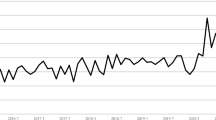Abstract
In this paper we propose a model which combines the spatial interaction models with the latest developments in internal market structure analysis and allows us to infer supermarket competition from revealed preference data. Using a nested logit formulation we model consumers' store choice decisions to be a two stage process in which consumers choose first the suburb and then the store from which to buy groceries. Hence, our method allows retail managers not only to understand the advantage (or disadvantage) of having their store chain in a particular area but also assess the competition within that area. Comparisons to Factor Analytic Choice Map is made.
Similar content being viewed by others
References
Bawa, Kapil, Jane T., Landwehr and Krishna, Aradhna. (1989) “Consumer Response to Retailers', Marketing Environments: An Analysis of Coffee Purchase Data,” Journal of Retailing. 65 (4), 471–495.
Chib, Siddharth, Greenberg, Edward and Chen, Yuxin. (1998) “MCMC Methods for Fitting and Comparing Multinomial Response Models,” Working Paper. University of Washington.
Chintagunta, Pradeep K. (1994) “Heterogenous Logit Model Implications for Brand Positioning,” Journal of Marketing Research. 3 (2), 304–311.
Corstjen, Judith and Corstjen, Marcel. (1996) Store Wars: The Battle for Mindspace and Shelfspace. John Wiley: New York.
Elrod, Terry. (1988) “Choice Map: Inferring a Product Market Map from Panel Data,” Marketing Science. 7(1), 21–40.
Elrod, Terry. (1991) “Internal Analysis of Market Structure: Recent Developments and Future Prospects,” Marketing Letters. 2, 253–266.
Elrod, Terry and Michael Keane, P. (1995) “A Factor Analytic Model for Representing the Market Structure in Panel Data,” Journal of Marketing Research. 32, 1–16.
Erdem, Tulin. (1993) “Dynamic Brand Choice and Product Market Signalling under Imperfect Information,” Unpublished Manuscript. University of Alberta.
Erdem, Tulin. (1996) “A Dynamic Analysis of Market Structure Based on Panel Data,” Marketing Science. 15(4), 359–378.
Erdem, Tulin and Keane, Michael P. (1996) “Decision Making Under Uncertainty: Capturing Brand Choice Processes in Turbulent Goods Market,” Marketing Science. 15(1), 1–20.
Erdem, Tulin and Winer, Russell S. (1999) “Econometric Modeling of Competition: A Multi-category Choice Based Mapping Approach,” Journal of Econometrics. 89, 159–175.
Hoch, Stephen J., Kim, Byung-Do, Montgomery, Alan L. and Rossi, Peter E. (1995) “Determinants of Store-Level Price Elasticities,” Journal of Marketing Research. 32 (February), 12–29.
Hoch, Stephen J., Dréze Xavier and Purk, Mary E. (1994) “EDLP, Hi-Lo and Margin Arithmetic,” Journal of Marketing. 58 (October), 16–27.
Huff, D. L. (1963) “A Probabilistic Analysis of Shopping Center Trade Areas,” Land Economics. 39, 81–90.
Kamakura, Wagner and Russell, G. J. (1989) “A Probabilistic Choice Model for Market Segmentation and Elasticity Structure,” Journal of Marketing Research. 26, 379–390.
Kamakura, Wagner and Russell, G. J. (1992) “Measuring Brand Value with Scanner Data,” International Journal of Research in Marketing. 10 (March), 9–22.
Kau, Ah Keng and Ehrenberg, A. S. C. (1984) “Patterns of Store Choice”, Journal of Marketing Research. 21 (November), 399–409.
Kumar, V. and Leone, Robert P. (1990) “Measuring the Effects of Retail Store Promotions on Brand and Store Substitution,” Journal of Marketing Research. 25 (May), 178–85.
Popkowski Leszczyc, Peter T. L. and Timmermans, H. (1997) “Consumer Store Choice Dynamics: An Empirical Analysis of the Competitive Market Structure for Grocery Stores,” Working Paper. University of Alberta.
Louviere, J. J. and Gaeth, G. J. (1987) “Decomposing the Determinants of Retail Facility Choice Using the Method of Hierarchical Information Integration: A Supermarket Illustration,” Journal of Retailing. 63, 25–48.
McCulloch, R. E. and Rossi, P. E. (1994) “Exact Likelihood Analysis of the Multinomial Probit Model,” Journal of Econometrics. 64, 207–240.
McFadden, D. (1991) “Advances in Computation, Statistical Methods and Testing of Discrete Choice Models,” Marketing Letters. 2, 215–229.
Meyer, R. J. and Eagle, T. C. (1982) “Context-Induced Parameter Instability in a Disaggregate Stochastic Model of Store Choice,” Journal of Marketing Research. 19, 62–71.
Rubin, D. B. (1987) Comment on “The Calculation of the Posterior Distribution by Data Augumentation,” by M. A. Tanner and W. H. Wong. Journal of the American Statistical Association. 82, 543–546.
Russell, Gary J. and Kamakura, Wagner A. (1994) “Understanding Brand Competition Using Micro and Macro Scanner Data,” Journal of Marketing Research. 31 (2), 289–303.
Weisbord, G. E., Parcells, R. J. and Kern, C. (1984) “A Disaggregate Model for Prediciting Shopping Area Market Attraction,” Journal of Retailing. 60, 65–83.
Wittink, Dick R., Addona, Michael J., Hawkes, William J. and Porter, John C. (1987) “SCAN*PRO: A Model of Promotional Activities on Brand Sales, Based on Store-Level Scanner Data,” unpublished Working Paper. Cornell University.
Wrigley, N. and Dunn, R. (1984a) “Stochastic panel-data models of urban shopping behaviour: 1. Purchasing at individual stores in a single city,” Environment and Planning A. 16, 629–650.
Wrigley, N. and Dunn, R. (1984b) “Stochastic panel-data models of urban shopping behaviour: 2. Multistore Purchasing patterns and the Dirichlet model,” Environment and Planning A. 16, 759–778.
Author information
Authors and Affiliations
Rights and permissions
About this article
Cite this article
Sinha, A. Understanding Supermarket Competition Using Choice Maps. Marketing Letters 11, 21–35 (2000). https://doi.org/10.1023/A:1008190508803
Issue Date:
DOI: https://doi.org/10.1023/A:1008190508803




